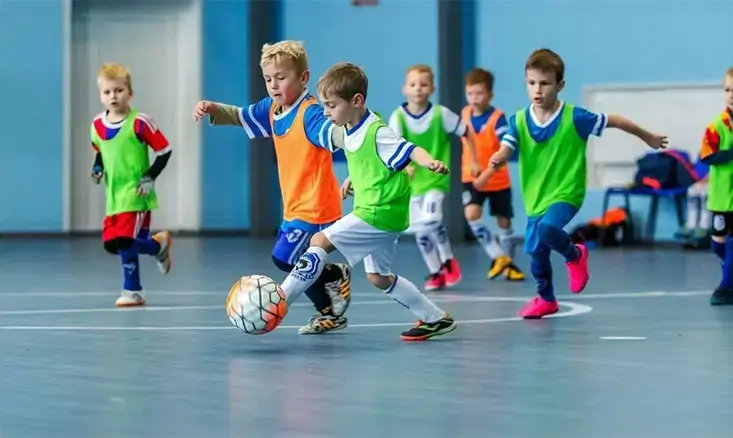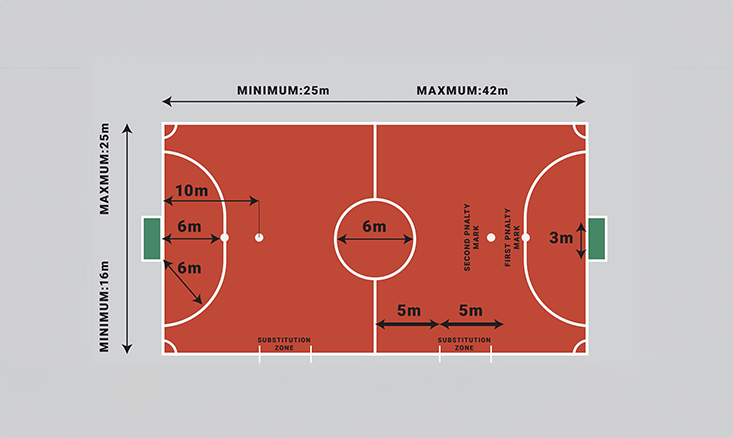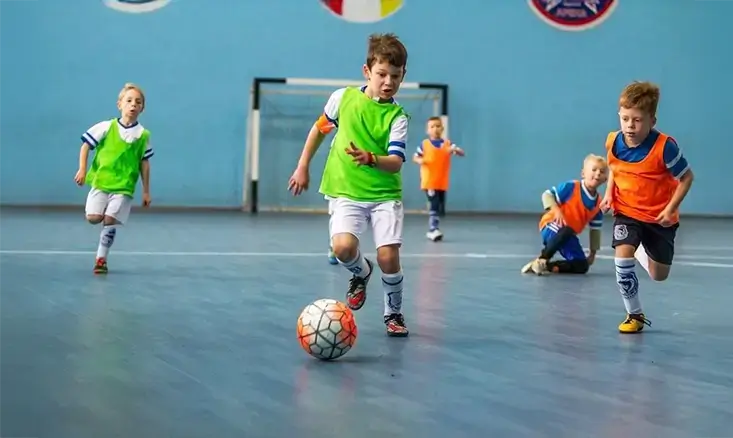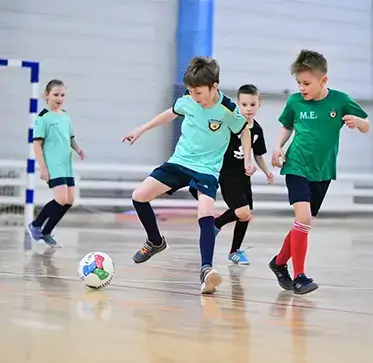CRFC BLOGS
LATEST BLOGS & NEWSLETTERS
Youth Soccer Indoor Rules: A Comprehensive Guide for Players, Coaches, and Parents
Youth indoor soccer is a unique version of traditional soccer that operates on a smaller, enclosed field and emphasizes speed, control, and teamwork. The game is fast-paced, requires fewer players on the field, and adapts many rules to fit the indoor environment. These variations make youth indoor soccer fun.
This guide covers game format, player substitutions, and specific goalkeeper regulations. With this understanding, players and teams can engage fully and confidently in the game!
Indoor Youth Soccer Rules
Indoor youth soccer rules differ significantly from outdoor soccer due to the smaller field and enclosed space. Here are some major differences:
Field Size and Boundaries
Indoor soccer fields are much smaller than outdoor fields, so players are constantly involved in the action. The enclosed field often has walls or netting, keeping the ball in play more often and reducing stoppages. The smaller size encourages quick footwork, short passes, and fast transitions between offense and defense.
Player Positions
In outdoor soccer, teams usually consist of 11 players per side, including a goalkeeper. Indoor youth soccer teams are smaller, typically consisting of four field players and one goalkeeper. This format requires players to stay engaged in both offensive and defensive roles throughout the game, encouraging well-rounded skill development.
No Offside Rule
In indoor soccer, the offside rule doesn’t apply, which gives players more freedom to move and position themselves. This rule change can make the game more dynamic, as players don’t have to worry about staying onside and they can focus on finding open spaces to receive passes and create scoring opportunities.
Pacing and Game Length
Indoor soccer games are typically shorter and split into two halves or even quarters, depending on the age group. The shorter game format aligns well with the intensity of the indoor game, as players are continuously moving and engaging with the ball due to the compact field.
Understanding these differences helps players and coaches adjust their strategies and get the most out of their indoor soccer experience.

Indoor Youth Soccer Rules and Regulations
Indoor youth soccer rules are tailored to create a safe, fast-paced game that emphasizes skill development and teamwork. Let’s explore some of the essential rules and regulations for youth indoor soccer.
1. Game Format and Timing
One of the main differences between indoor and outdoor soccer is the game format and timing. Indoor soccer games are designed to be shorter and more intense:
Game Length
The length of indoor soccer games for youth depends on the age group. For older youth players, games are often divided into two halves of 20 minutes each, while younger age groups may play in four shorter quarters, typically around six minutes each. These shorter game segments keep younger players engaged and focused without causing fatigue.
Timeouts
Each team is allowed one 30-second timeout. This timeout can be used when the team has possession and the ball is out of play. This brief pause allows coaches to give feedback, make adjustments, or encourage players during the game.
Overtime (for Playoffs)
In playoff situations, tied games may go into a 3-minute golden-goal overtime. In a golden-goal scenario, the game ends as soon as a team scores. If the game is still tied after overtime, penalty kicks may be used to decide the winner.
This structure of timing and game breaks allows indoor soccer to stay intense and competitive while ensuring the game doesn’t go on too long for younger players.
2. Team Composition and Player Positions
-
Number of Players
Youth indoor soccer teams typically consist of four field players and one goalkeeper. Some younger divisions may allow additional field players and may even play without a designated goalkeeper to simplify the game for beginners. -
Goalkeeper Requirements
The goalkeeper must wear a different color jersey or shirt to make it easy for players, coaches, and referees to identify them on the field. This rule ensures that everyone on the field can quickly recognize the goalkeeper, who must follow specific rules for ball handling.
3. Substitution Rules
Indoor soccer allows for more flexible substitutions to help players keep up with the fast-paced action on the smaller field:
On-the-Fly Substitutions
Players are allowed to substitute on the fly, meaning that substitutions can happen while the game is in play without needing a stoppage. However, the incoming player must wait until the exiting player has fully left the field before entering. This system keeps the game moving and reduces downtime.
Substitution Zone
All substitutions must occur within the designated technical area, which is typically located near the team benches. This area ensures that substitutions happen smoothly and safely without causing confusion or interference on the field.
These substitution rules make indoor youth soccer more fluid and dynamic, allowing players to quickly enter and exit as needed to maintain high energy levels.

Essential Indoor Youth Soccer Gameplay Rules
Indoor youth soccer has distinct rules for starting and restarting play, scoring, and managing fouls. Here’s a closer look at these specific gameplay rules:
Restarts and Scoring Rules
-
Kickoffs and Kick-ins
Kickoffs at the start of the game and after each goal are indirect, meaning the ball must touch another offensive player before a goal can be scored. The ball should be placed within 10 inches of the line for kick-ins, and the kick must also be indirect. For younger players (usually ages 4-6), throw-ins can allow simpler skill-building.
-
Goal Clearances
When the ball crosses the goal line after being last touched by the attacking team, the goalkeeper must restart the game with a goal clearance. The goalkeeper can roll, throw, or bounce the ball back into play from within the penalty area, but they must use their hands to start the play.
-
Corner Kicks
Corner kicks are direct, meaning a goal can be scored directly from the kick. This creates exciting scoring opportunities for teams.
-
Free Kicks
All free kicks in indoor youth soccer are indirect. This rule requires players to pass the ball to a teammate rather than attempting a direct shot on goal, promoting teamwork and passing accuracy.
-
Penalty Kicks
Penalty kicks are taken from a designated spot and involve a one-on-one situation with the goalkeeper. Unlike outdoor soccer, rebounds are not allowed on penalty kicks in youth indoor soccer. Once the ball is kicked, the play either results in a goal or continues with a goal kick if missed.

Fouls and Misconduct
-
Free Kicks for Fouls
Any foul committed by a player results in an indirect free kick for the opposing team. This includes fouls like pushing, tripping, or unsportsmanlike behavior.
-
Yellow and Red Cards
A yellow card is a caution for minor infractions, such as repeated fouls or unsporting behavior. If a player receives two yellow cards in a single game, they receive a red card and are ejected. A red card results in the offending team playing with one fewer player for two minutes or until the opposing team scores.
-
Advantage Rule
In situations where a foul occurs but the fouled team maintains possession and a clear advantage, referees can apply the advantage rule, allowing play to continue without stopping.
Special Goalkeeper Rules for Youth Indoor Soccer
-
No Drop-Kicking or Airborne Kicks
In indoor soccer, goalkeepers are not allowed to drop-kick or kick the ball directly from their hands in the air. Instead, they must ground the ball before kicking it to prevent high, uncontrolled kicks that might hit the ceiling or other players.
-
Ball Handling Time Limit
The goalkeeper can only hold the ball for up to five seconds in their half to keep the game flowing. This limit prevents stalling and encourages the goalkeeper to release the ball quickly.
-
Scoring Limitations
While the goalkeeper can score directly with their feet during active play, they cannot throw the ball directly into the opposing goal. If they do, it results in a goal clearance for the opposing team.
Conclusion
Youth indoor soccer offers a fast-paced, action-packed version of the game that challenges players to hone their skills, teamwork, and agility. With specific rules around game length, team composition, substitutions, scoring, and conduct, youth indoor soccer provides a well-rounded environment for young players to develop their skills and sportsmanship.
FAQs
What is the difference between indoor and outdoor youth soccer rules?
Indoor soccer is faster-paced with fewer players. It’s played on a smaller, enclosed field, and there’s no offside rule. Games are generally shorter than outdoor matches.
How long is a youth indoor soccer game?
Youth indoor soccer games typically last two 20-minute halves for older players. Younger players might play four quarters of about 6 minutes each.
Can youth indoor soccer goalkeepers kick the ball in the air?
No, goalkeepers in youth indoor soccer cannot drop-kick or kick the ball directly from their hands in the air. They must roll, throw, or pass it from the ground to restart play.
Are there penalty kicks in youth indoor soccer?
Yes, penalty kicks are allowed in youth indoor soccer. They are taken from a designated spot, with the shooter going one-on-one with the goalkeeper, but rebounds are not allowed.
Is there an offside rule in youth indoor soccer?
No, the offside rule does not apply in youth indoor soccer. This allows players to move freely, creating more scoring opportunities in the smaller, enclosed field.

Did you find this useful?


